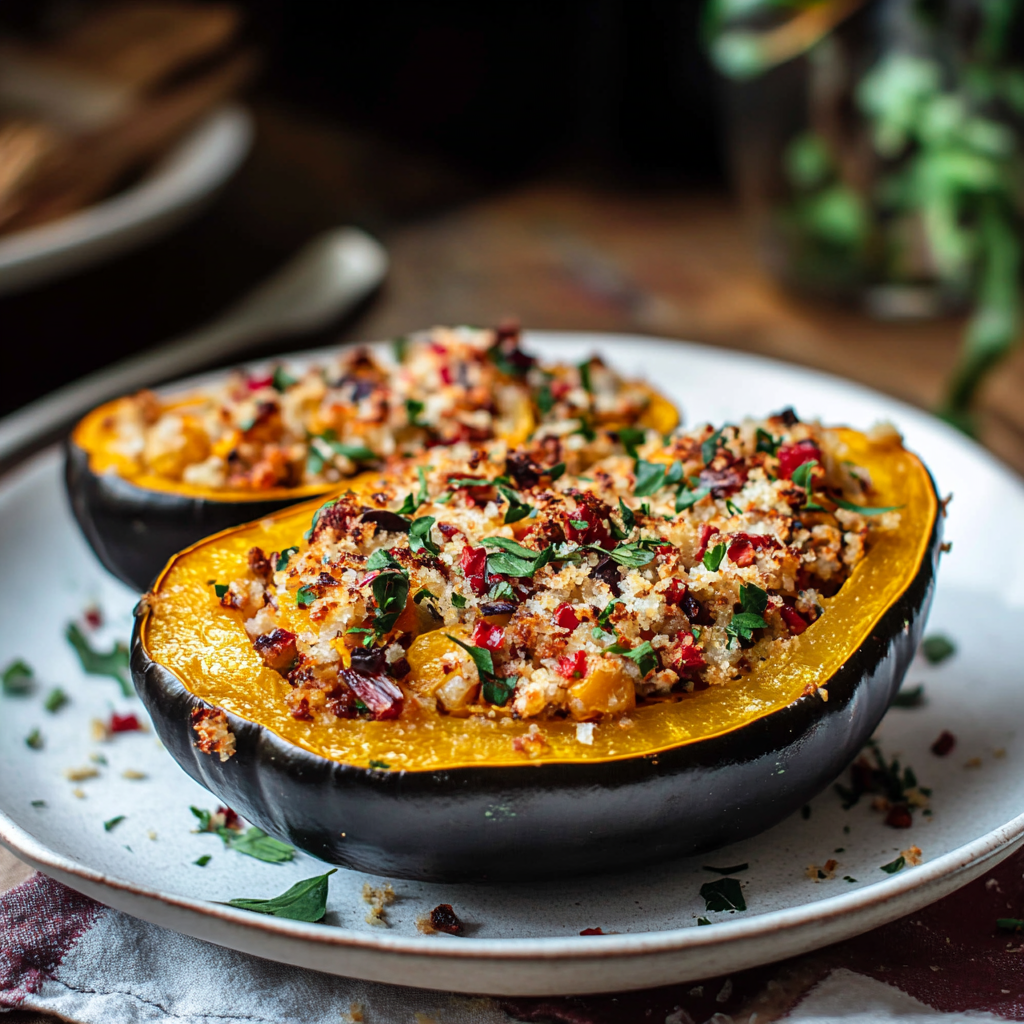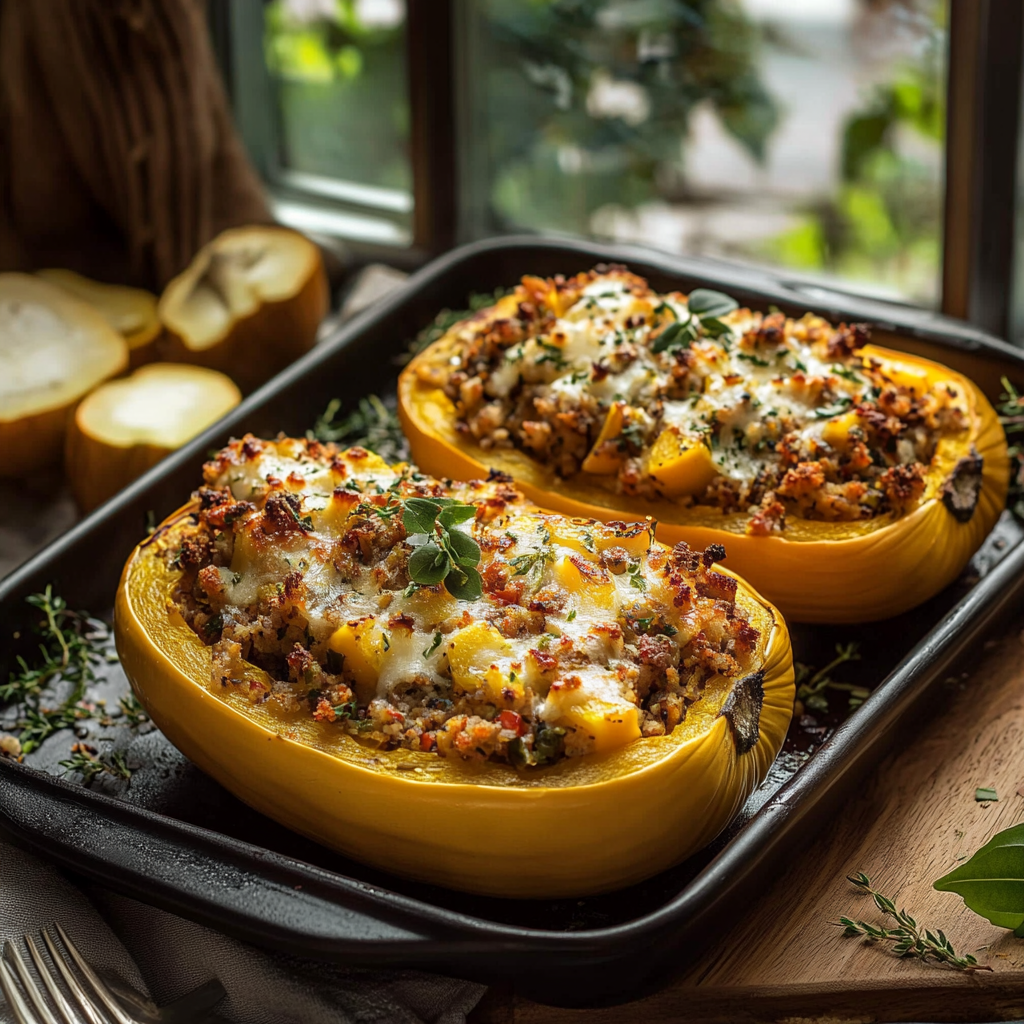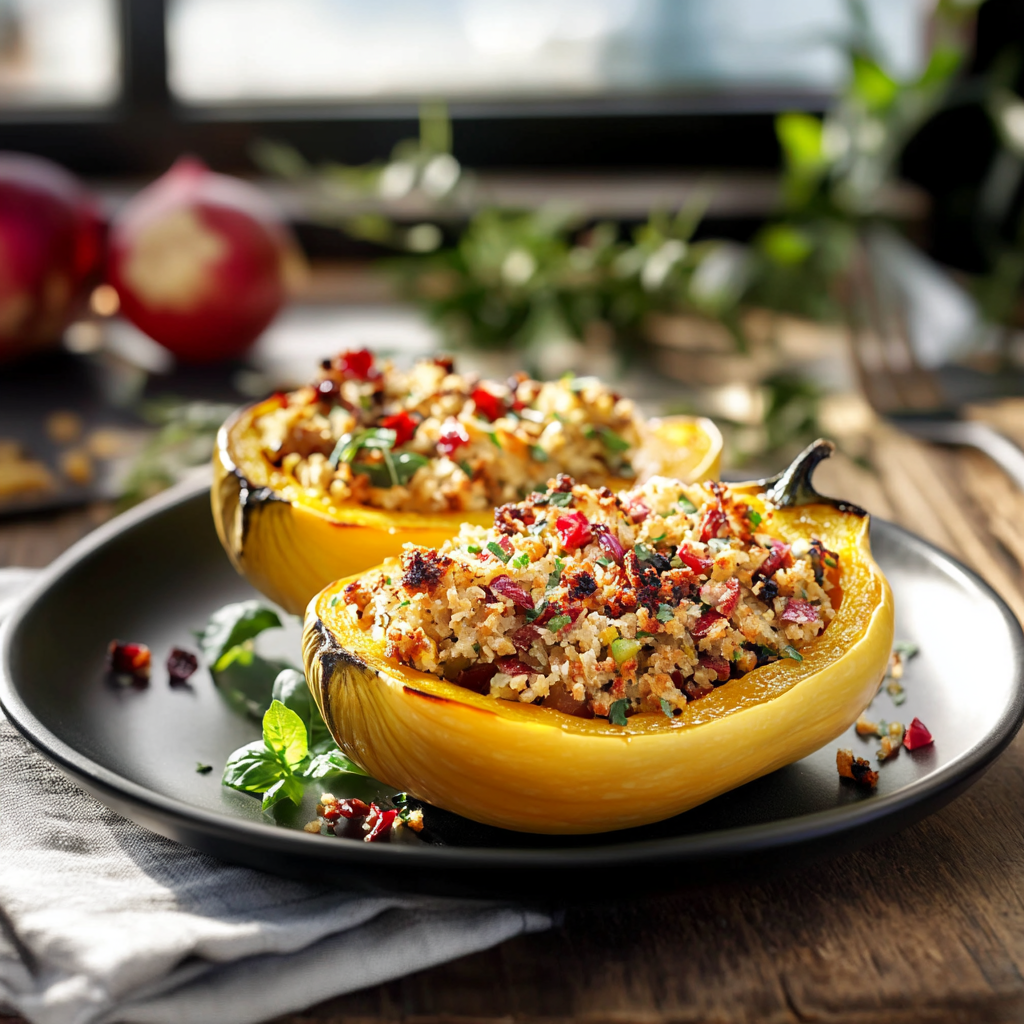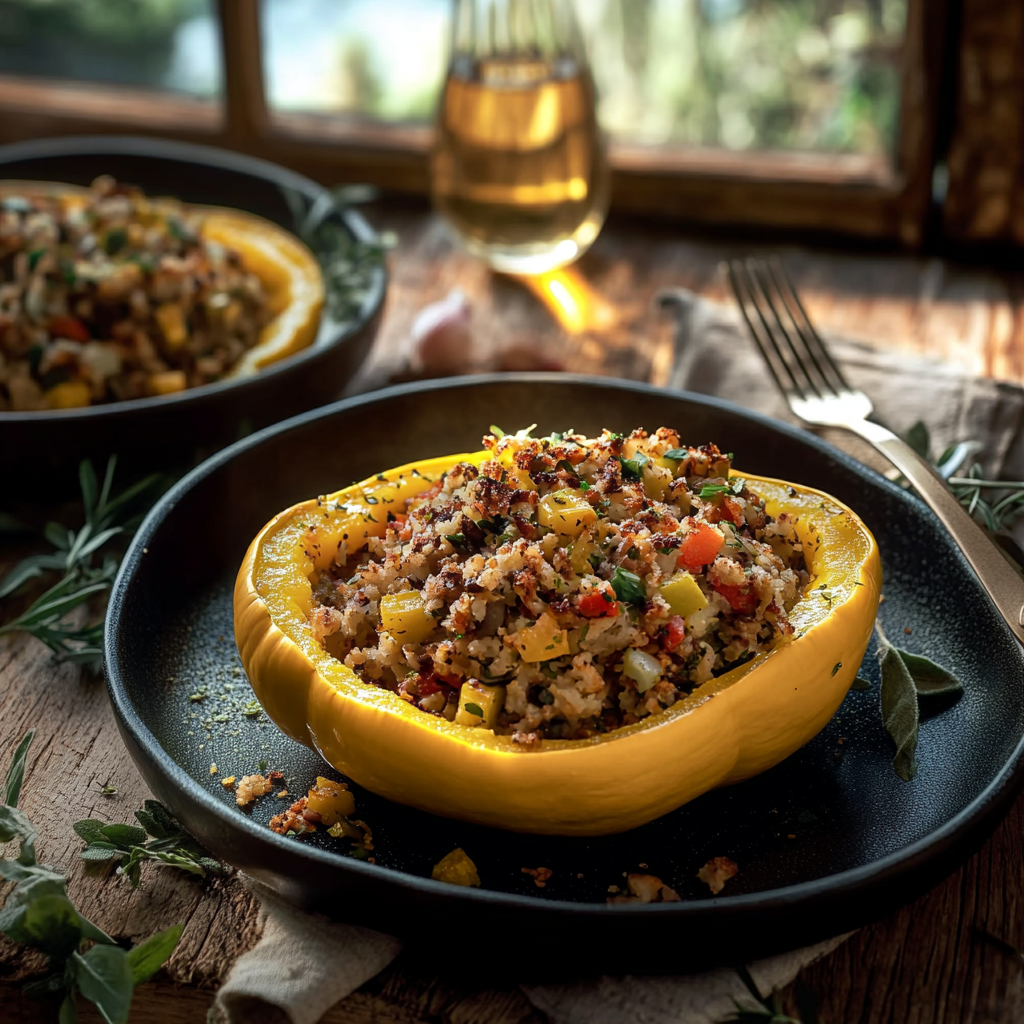Introduction and Quick Summary
Vegan Stuffed Squash is an enticing dish that brings together the rich flavors of seasonal vegetables and wholesome grains in a delightful way. This recipe is not just easy to prepare; it also packs a nutritious punch, making it perfect for both weeknight dinners and special occasions. Imagine a vibrant acorn or butternut squash filled with a savory mixture of quinoa, black beans, and aromatic spices, all topped with fresh herbs. This dish not only impresses your guests but also satisfies your cravings for comfort food.
Whether you’re a long-time vegan or just looking to incorporate more plant-based meals into your diet, this stuffed squash recipe will quickly become a favorite. It’s versatile enough to adapt based on the ingredients you have on hand or your personal taste preferences. Plus, it’s visually striking—serving up a baked squash at the dinner table creates an impressive centerpiece that delights everyone.
In this article, you’ll find detailed instructions on how to prepare this delightful dish from scratch. We’ll cover the main ingredients you need and share step-by-step preparation methods that ensure your Vegan Stuffed Squash turns out perfectly every time. Let’s dive into the world of plant-based cooking where flavor meets nutrition!
Main Ingredients
Acorn Squash
Acorn squash is an excellent choice for stuffing due to its naturally sweet flavor and unique shape. Each medium-sized acorn squash typically weighs about 1 to 2 pounds and serves as the perfect vessel for our filling. Rich in vitamins A and C, as well as fiber, this ingredient elevates both the nutritional value and taste of the dish. To prepare them for stuffing, you’ll need to slice them in half lengthwise and scoop out the seeds.
Quinoa
Quinoa serves as the base for our filling; it’s gluten-free and packed with protein, making it an ideal ingredient for any vegan meal. For this recipe, you’ll need about 1 cup of uncooked quinoa. When cooked, it expands significantly—yielding approximately 3 cups of fluffy grains that mix beautifully with other ingredients. Rinse quinoa under cold water before cooking to remove any bitterness from its coating.
Black Beans
Black beans add texture and protein to our Vegan Stuffed Squash mix. You can use one can (15 oz) of drained and rinsed black beans or cook dried black beans from scratch (about 1/2 cup dry). They offer a creamy consistency when mashed slightly but still maintain some bite when left whole. Additionally, black beans are rich in iron and fiber.
Bell Peppers
Colorful bell peppers bring freshness and crunch to our stuffing mixture. You’ll need about 1 medium-sized bell pepper—red or yellow work best for their sweetness—but feel free to use green if you prefer a more pronounced flavor. Dice the pepper finely so it integrates seamlessly into the filling while adding vibrant color.
Onion
Onion provides depth of flavor in our Vegan Stuffed Squash recipe. One medium onion will suffice; yellow onions are commonly used due to their sweetness when sautéed but feel free to use red onions for added color and sharpness if desired. Chop finely so they cook evenly along with other vegetables.
Spices
A blend of spices enhances all the flavors in our filling: cumin adds earthiness; smoked paprika lends warmth; garlic powder offers depth; salt brings everything together; while freshly ground black pepper adds just enough heat without overwhelming the dish itself.

How to Prepare Vegan Stuffed Squash
Step 1: Preheat Your Oven
Begin by preheating your oven to 375°F (190°C). Preheating ensures that your vegan stuffed squash cooks evenly throughout its baking time. While waiting for the oven temperature to rise, prepare your acorn squashes by cutting them in half lengthwise using a sharp knife—this allows you to easily scoop out their seeds later on.
Once halved, carefully place each half cut-side down on a baking sheet lined with parchment paper or aluminum foil—this prevents sticking during cooking time! Roast them in the preheated oven for about 25-30 minutes until tender when pierced with a fork yet firm enough so they hold their shape during stuffing later on.
Step 2: Cook Quinoa
While your acorn squashes are roasting away blissfully in the oven, it’s time to cook your quinoa! In a medium saucepan over high heat, combine 1 cup rinsed quinoa with two cups water (or vegetable broth for added flavor). Bring this mixture up to a boil before reducing it down low—covering tightly allows steam circulation which helps achieve fluffy results!
Let simmer gently for around 15 minutes until all liquid has been absorbed—fluffing it gently using a fork afterward creates lightness within each grain! Set aside once done cooking so that it cools slightly before mixing into other ingredients later on.
Step 3: Sauté Vegetables
Next up is sautéing those delicious diced onions alongside chopped bell peppers! Heat about one tablespoon olive oil over medium-high heat in another skillet until shimmering but not smoking—a good indicator that oil has reached optimal temperature!
Add chopped onions first—sauté them until translucent (approximately five minutes)—then toss in diced bell peppers afterward! Stir frequently so nothing burns while allowing veggies’ natural sweetness develop through caramelization—the goal here is achieving soft yet slightly crisp veggies without losing their color vibrancy!
Continue stirring intermittently until both vegetables have softened nicely (usually around five more minutes). Once complete transfer sautéed mixture directly into large mixing bowl containing cooked quinoa!
Step 4: Combine Filling Ingredients
Now comes the fun part—combining everything together! In your large bowl filled with sautéed veggies mixed alongside fluffy quinoa add drained black beans plus any desired spices mentioned earlier! Stir gently yet thoroughly ensuring even distribution among all components—the result should be well-blended flavors bursting forth from every spoonful!
Taste-test at this stage adjusting seasoning if necessary—a sprinkle more salt or dash extra cumin might elevate those outstanding flavors even further! Once satisfied set aside prepared stuffing mix while you wait patiently for roasted acorn squashes cooling down slightly before moving onto next steps.
Step 5: Stuff & Bake
Once roasted acorn squashes have cooled enough such that they can be handled safely use spoon carefully fill each cavity generously with flavorful stuffing mixture prepared earlier—it’s okay if some spills over—that adds rustic charm while baking too!
Afterward place filled halves back onto baking sheet (cut side up) then drizzle remaining olive oil lightly over tops followed by another pinch salt/pepper seasoning if desired! Return everything back into preheated oven bake uncovered until heated through fully golden brown typically around fifteen-twenty minutes depending upon individual oven characteristics!
When finished let cool slightly before serving garnished optionally freshly chopped parsley or cilantro atop bringing additional color contrast plus bright herbal notes enhancing overall aesthetic appeal at table presentation!

Serving and Storing Tips
Serving Suggestions
Vegan Stuffed Squash makes an incredible centerpiece dish fit for any occasion! Serve hot right out of the oven alongside simple side salads featuring mixed greens dressed lightly vinaigrette providing refreshing contrast against richness provided by nutty flavors within filling itself! Pairing nicely also includes roasted vegetables such as asparagus or Brussels sprouts drizzled balsamic glaze compliments wonderfully too!
For larger gatherings consider serving these delightful halves family-style allowing guests help themselves customizing portions according preferences—perhaps offering various toppings like avocado slices dollops cashew cream spicy salsa topping options available encourages creativity dining experience!
Don’t forget about drink pairings too—a chilled white wine like Sauvignon Blanc enhances bright citrus notes found within dish meanwhile sparkling water infused lemon-lime balances richness well keeping palate refreshed throughout meal enjoyment process!
Storage Guidelines
If you happen fortunate leftovers after gathering friends/family together don’t fret—they store beautifully! Allow cooled stuffed squashes rest completely room temperature before transferring airtight container refrigerate up-to four days maximum freshness retained longer storage periods may affect texture/flavor quality experienced upon reheating later on!
To reheat simply place desired portion onto microwave-safe plate cover loosely then microwave intervals checking regularly don’t lose moisture content (typically around two-three minutes suffice!). Alternatively bake them again at lower temperature approximately ten-fifteen minutes ensuring heated thoroughly without drying out results staying moist inside while crispy outside maintains appealing contrast textures enjoyed initially served fresh!
Mistakes to avoid
One common mistake when preparing vegan stuffed squash is not choosing the right squash. Selecting a variety that is tough or lacks flavor can lead to disappointing results. Opt for squashes like acorn, butternut, or delicata, which have a sweeter taste and tender flesh that complements stuffing beautifully. Ensure you choose squash that feels heavy for its size and has a firm skin without blemishes.
Another pitfall is overcooking the squash. It’s essential to monitor cooking time carefully as overcooked squash can become mushy and lose its appealing texture. Aim for a tender yet firm consistency so that the stuffing holds well within the squash. Baking at the right temperature—around 375°F for about 25-35 minutes—helps maintain this ideal texture.
Failing to season adequately is also a frequent oversight. Squash can be naturally sweet, but without proper seasoning, it may taste bland. Use herbs and spices such as thyme, rosemary, garlic powder, salt, and pepper to enhance flavors significantly. Additionally, consider adding citrus zest or juice for a fresh kick.
Lastly, neglecting to balance the filling can lead to poor flavor combinations. Make sure your stuffing includes various textures and tastes—think grains like quinoa or rice paired with legumes, nuts, or vegetables. This will create a well-rounded dish that is satisfying and nutritious.

Tips and tricks
When making vegan stuffed squash, preparation plays a crucial role in achieving culinary success. Start by washing the squash thoroughly to remove any dirt before cutting it in half. Scoop out the seeds using a spoon to create enough space for your filling. A melon baller works well if you’re looking for precision.
Consider pre-cooking your filling ingredients separately before combining them with any raw components inside the squash. This ensures everything cooks evenly and enhances flavor development as well. For instance, sauté onions and garlic until fragrant before mixing them with cooked grains or legumes.
Another useful tip is to experiment with different fillings based on seasonal ingredients available in your area. Fall brings an abundance of mushrooms, kale, and root vegetables that pair perfectly with stuffed squash dishes. This approach not only enhances freshness but also keeps your meal exciting throughout the year.
Don’t forget about presentation! After baking your vegan stuffed squash, allow it to cool slightly before serving. Drizzle a balsamic glaze or sprinkle fresh herbs on top for an appealing finish that elevates the dish visually while also adding extra flavor.
Lastly, batch cooking is highly recommended if you enjoy meal prep. Prepare multiple squashes at once so you can store leftovers in airtight containers in the fridge for easy access throughout the week.
Suggestions for Vegan Stuffed Squash
For delicious vegan stuffed squash dishes, select complementary sides that elevate your meal experience without overwhelming it. A light salad featuring mixed greens dressed simply with olive oil and lemon juice pairs wonderfully with rich stuffed squash offerings.
Consider serving alongside grains like farro or couscous seasoned with herbs; these can provide an additional layer of texture while enhancing the overall dish’s nutritional profile.
If you want more protein in your meal, pair stuffed squash with chickpea salad topped with diced cucumbers, tomatoes, and tahini dressing for added creaminess. This combination not only looks vibrant on the plate but also satisfies hunger effectively.
Don’t overlook dipping sauces either! A cashew-based cream sauce drizzled over each serving adds richness that contrasts nicely against the sweetness of roasted squash. Alternatively, spicy harissa sauce provides heat that balances flavors beautifully.
Lastly, think about breakfast options too! Leftover stuffed squash makes excellent additions to scrambles or breakfast bowls when diced up—the flavors meld beautifully when reheated together.

FAQs
What types of squash are best for stuffing?
Choosing the right type of squash is vital for your vegan stuffed dish’s success. Popular varieties include acorn, butternut, and delicata squashes due to their size and sweetness when cooked. Acorn squashes offer a lovely shape that’s perfect for holding fillings while providing delightful natural sweetness; however, butternut tends to have smoother flesh ideal if you’re looking for creamy textures inside each bite! Delicata offers unique edible skin making it versatile too!
Can I make vegan stuffed squash ahead of time?
Absolutely! Preparing your vegan stuffed squash ahead saves time during busy weeknights or special occasions where you want minimal stress while entertaining guests at home! You can assemble everything—the filling combined into halved scooped-out squashes—then cover each tightly before refrigerating until ready to bake later on! Just ensure they’re brought back up closer room temperature prior placing them into preheated oven so they cook evenly through!
How long does vegan stuffed squash last in the fridge?
If stored properly in an airtight container after cooking (or assembling), vegan stuffed squashes typically last about 3-5 days in refrigeration without losing quality! If you’d like longer shelf life options available consider freezing unbaked ones instead; this way they’ll remain fresh-tasting even months later when you’re ready enjoy again!
Can I use non-vegan ingredients in my stuffing?
While this recipe focuses on plant-based options tailored specifically towards those seeking vegan meals—you may choose different ingredients based on personal preferences if you’re not strict about dietary restrictions! Just remember adjusting seasonings accordingly will help maintain flavors well-balanced throughout dish no matter what kind proteins used!
What are some good substitutions for common ingredients?
Many ingredients used within typical recipes have great alternatives suited towards various dietary needs! For instance: quinoa could substitute brown rice easily; nutritional yeast makes excellent cheese replacement while adding depth flavor-wise! You could even use lentils instead ground meat mixtures often found traditional recipes—they’ll add heartiness texture without compromising taste whatsoever!
Is it possible to grill stuffed squash instead of baking?
Yes indeed! Grilling adds another dimension of flavor through its smoky charred notes giving each bite something special beyond just oven-baked versions alone! Simply prepare as directed above then wrap securely with foil ensuring they won’t fall apart during cooking process; place directly onto grill grate medium-low heat ensuring even cooking until tender throughout!
Conclusion
In summary, creating delicious vegan stuffed squash requires careful consideration of both ingredient selection and preparation methods. Avoid common pitfalls such as choosing unsuitable squashes or neglecting seasoning by incorporating flavorful herbs and spices into your stuffing mix. Utilize tips like balancing textures within fillings while experimenting with seasonal produce ensures every dish remains exciting year-round!
Additionally, consider thoughtful side pairings along with presentation enhancements that elevate meals visually as well as gastronomically enjoyable experiences overall! Lastly don’t hesitate exploring alternative methods including grilling techniques which open new avenues exploration regarding flavors potential vast array of possibilities achievable through simple culinary swaps made along way too—happy cooking everyone!

